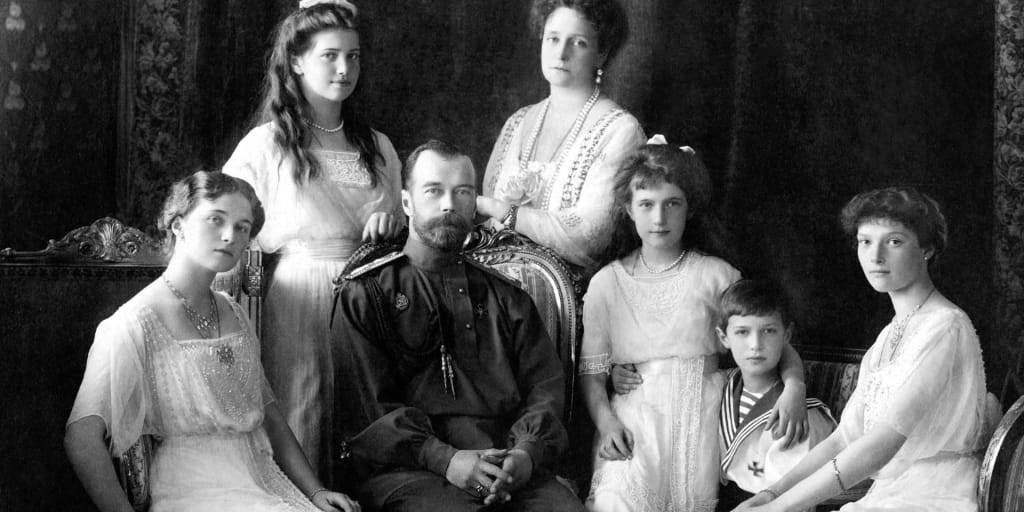The Romanov family ruled over the Russian Empire for over 300 years until their tragic execution in 1918 during the turmoil of the Russian Revolution. The last Tsar of Russia, Nicholas II, his wife Alexandra, and their five children Olga, Tatiana, Maria, Anastasia, and Alexei enjoyed a life of opulence and privilege as the imperial family. However, growing civil unrest and Nicholas' resistance to reform would ultimately lead to revolution.
In 1917, amidst the upheaval of World War I, starving Russians began protesting against food shortages and the failings of the tsarist regime. As demonstrations and strikes erupted across the country, Nicholas stubbornly refused to share power or establish a more democratic form of government. By March, the tsar had abdicated under pressure and a provisional government was formed. But this new government faced its own struggles to establish order and unite the country.
Later that year, the leftist Bolshevik party seized power in the October Revolution, vowing to pull Russia out of the war and give greater rights to workers and peasants. The Bolsheviks, led by Vladimir Lenin, were opposed to the old order and the concept of monarchy. Now seen as a threat to the revolution, Nicholas and his family were forced into house arrest in Alexander Palace.
The following year, civil war broke out between the Red Army led by the Bolsheviks and anti-communist White forces. In July 1918, with anti-Bolshevik forces approaching, Lenin ordered the execution of the Romanovs to prevent any attempt to restore the monarchy. Nicholas, Alexandra, their five children, family doctor, three servants and pet dog were gunned down by a Bolshevik execution squad in the basement of a house in Yekaterinburg.
The murdered Romanovs were hastily buried in unmarked graves in nearby woods as the executioners attempted to erase all traces of the Imperial family. With their slaughter, the 300-year dynasty of the House of Romanov came to a violent end. For the revolutionary government, it was an ideological act to break from Russia's imperial past. But for monarchists, it was an unforgivable crime that robbed the Romanovs of justice.
In the ensuing chaos of revolution and civil war, the Romanov's fate was shrouded in mystery. Rumours swirled that some of the children had survived the hail of bullets. Most persistent were tales that the spirited 17-year-old Anastasia had escaped. Imposters in foreign countries claimed to be the Grand Duchess, adding to hopeful rumours she had cheated death.
The mystery fascinated the public's imagination for decades. Books, plays and films portrayed romanticized tales of Anastasia's possible survival. Most famously, the 1956 Hollywood film Anastasia starred Ingrid Bergman as an amnesiac orphan who may be the lost Grand Duchess. But the romantic notion of Anastasia's escape was not supported by historical evidence.
In 1991, the presumed burial site of the Romanovs was uncovered and an official investigation sought to finally determine what happened to the family. Advanced DNA analysis conclusively identified the remains of the Tsar, his wife and three daughters. While the bodies of Alexei and one sister were still missing, this discovery provided strong scientific evidence that the entire family was murdered that fateful night.
In 2007, amateur enthusiasts found a second grave in the woods containing bone fragments that DNA tests matched to Alexei and his sister Maria. After 90 years of doubt, the fate of the Romanovs was conclusively resolved. Scientific advances allowed their remains to finally be properly identified, laid to rest and their story definitively concluded.
The execution of the Romanovs marked the end of the imperial dynasty that had ruled Russia for centuries. While totalitarian communism would also eventually collapse, the tsarist regime would never be restored. The murder of the royal family underscored the uncompromising brutality of revolutionaries toward the old order. But it also showed how an out-of-touch monarch's resistance to change could lead to his downfall when confronted by the harsh tides of history. Their tragic story would come to symbolize the suffering, upheaval and ideologically-driven violence unleashed by the Russian Revolution.



No comments yet
Be the first to share your thoughts!